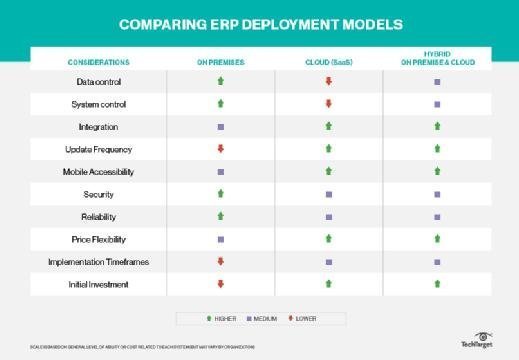
alphaspirit - Fotolia
SaaS ERP vs. cloud ERP: What's the difference?
SaaS ERP and cloud ERP represent two types of software systems that share some similarities. Learn what they have in common and how they are different.
Understanding the terms SaaS ERP and cloud ERP is a critical first step in understanding the enterprise technology landscape.
Here's how SaaS ERP and cloud ERP differ, as well as what they have in common.
What is cloud ERP?
ERP is a modular system of business software designed to run enterprise data. In an on-premises model, the software runs on an enterprise's on-premises servers and the IT team has complete responsibility for managing the system.
With cloud ERP, the ERP software is managed and delivered through remote servers. Companies pay vendors for the functionality and specific resources they need. Users can customize their cloud ERP by adding more resources or removing the ones they're no longer using. This makes cloud ERP much more flexible and scalable compared with on-premises versions. Companies are also able to access data in real-time. Vendors handle any maintenance, as well as updates to hardware and software.
Users can access cloud ERP through the internet, which enables businesses to more easily share data and collaborate with outside suppliers, partners and customers. Cost savings may result. Vendors maintain that cloud ERP offers increased security, but many business and IT leaders have concerns, such as whether a vendor can access their sensitive information.
Certain cloud ERP systems may allow an organization to have more control over its ERP system, but this choice comes with a higher price and requires more IT resources.
Cloud ERP can be public or private.

What is SaaS ERP?
SaaS ERP is a type of cloud-based ERP software that is sold through a monthly, per-user subscription and distributed as a service via the internet. SaaS ERP runs on a vendor's servers, and the vendor updates the software, typically on a quarterly basis.
SaaS ERP typically runs on a multi-tenant SaaS architecture. Vendors keep each tenant's data separate, although they share the software instance and supporting infrastructure and database.
A core benefit of a SaaS ERP system is that it's meant to be easy to use out of the box and the vendor manages updates and maintenance. This helps to promote system security, lower IT costs and protect the ERP system from threats and crashes. However, vendors typically offer standard features with little room for customization in this model.
Organizations using two-tier ERP frequently select SaaS ERP as the second tier of their ERP ecosystem.
Vendors may offer SaaS ERP in single-tenant mode in which a tenant does not share its software instance and database. Single-tenant SaaS ERP offers additional security and privacy, though the cost is higher than in a multi-tenant model.






